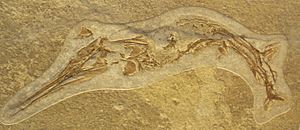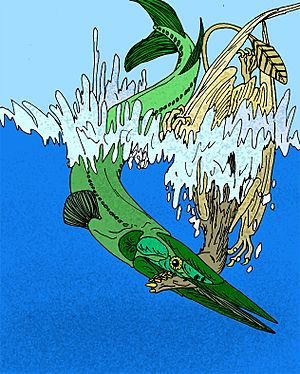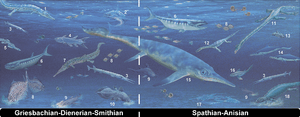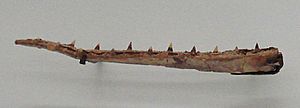Saurichthys facts for kids
Quick facts for kids Saurichthys |
|
|---|---|
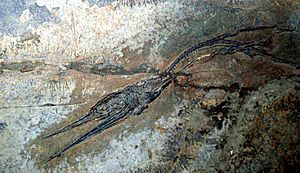 |
|
| Saurichthys fossil | |
| Scientific classification | |
| Kingdom: | |
| Phylum: | |
| Class: | |
| Order: |
†Saurichthyiformes
|
| Family: |
†Saurichthyidae
|
| Genus: |
†Saurichthys
Agassiz, 1834
|
| Type species | |
| †Saurichthys apicalis Agassiz, 1834
|
|
| Species | |
|
|
| Synonyms | |
|
|
Saurichthys (say "Saw-rik-this") was an ancient fish that lived during the Triassic period. Its name means 'lizard fish'. It was a fierce hunter with a long, pointy snout.
This fish was part of a group called ray-finned fish. Saurichthys is the main example for its family, the Saurichthyidae. This family also includes other ancient fish like Eosaurichthys and Saurorhynchus.
Scientists have found Saurichthys fossils on every continent except South America and Antarctica. This shows they lived in many different places. They could live in both ocean water and fresh water. The oldest fossils were found in Greenland.
Over 50 different kinds, or species, of Saurichthys have been found. They came in different sizes and had slightly different body parts. Some of the very old descriptions of these fish were based on just small pieces, like teeth.
Louis Agassiz first described Saurichthys in 1834. He called it the "lizard fish" because he thought its bones looked a bit like those of reptiles and fish mixed together.
Today, the closest living relatives of Saurichthys might be sturgeons, paddlefish, and bowfins. However, some recent studies suggest they might not be as closely related as once thought.
Contents
What did Saurichthys look like?
Saurichthys was a long, sleek fish. Most were about 0.6 to 1 meter (2 to 3 feet) long. Some species were smaller, only a few decimeters long. Others could grow much bigger, up to about 1.5 meters (5 feet) long.
These fish looked a lot like modern pike fish. They had their back fin (dorsal fin) and bottom fin (anal fin) placed far back on their body. Their tail was also symmetrical. These features helped them swim very fast.
Saurichthys likely hunted like a pike. It would hide and then suddenly dart out to catch its prey. Its jaws were super long, making up about one-third of its whole body length. The end of its jaws was sharp, like a beak.
Early Triassic species of Saurichthys had a longer skull behind their eyes. They also had more scales covering their body compared to later species.
What did Saurichthys eat?
Big Saurichthys species were top predators among the ray-finned fish in the Triassic period. They hunted alongside other large fish like Birgeria.
Scientists believe Saurichthys was an ambush predator. This means it would wait quietly for its prey. Then, it would attack with quick, sudden movements. Some types, like Sinosaurichthys, might have swum just below the water's surface.
Fossils show that Saurichthys sometimes ate other Saurichthys! This is called cannibalism. There is also fossil evidence that Saurichthys attacked or ate dead marine reptiles, like Langobardisaurus.
A study of the Saurichthys stomach and intestines found they were similar to modern sharks. They had many twists and turns, like a spiral. This helped them digest food better and get more energy. This suggests Saurichthys had a very active lifestyle.
How did Saurichthys reproduce?
Scientists have found fossils of pregnant female Saurichthys. These fossils show that Saurichthys gave birth to live young. This is called viviparity, and it's the oldest known example of live birth in ray-finned fish!
Males also had special body parts for reproduction. Some had unique pelvic fin rays, like in Saurichthys calcaratus. Others had special scales on their belly, like in Saurichthys curionii and Saurichthys macrocephalus. These parts helped them fertilize the eggs inside the female.
What are the different types of Saurichthys?
There are more than 50 known species of Saurichthys. Scientists group them into different categories based on their features. Some of these groups are:
- Saurichthys (Costasaurichthys)
- Saurichthys (Eosaurichthys)
- Saurichthys (Lepidosaurichthys)
- Saurichthys (Saurorhynchus)
- Saurichthys (Sinosaurichthys)
The very first species described was Saurichthys apicalis. Other well-known species include Saurichthys curionii and Saurichthys seefeldensis. Each species had its own unique characteristics.
More Pictures of Saurichthys
See also
 In Spanish: Saurichthys para niños
In Spanish: Saurichthys para niños


